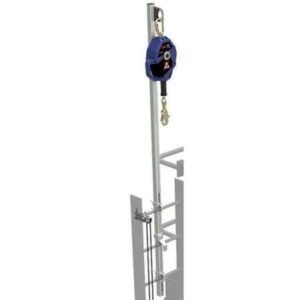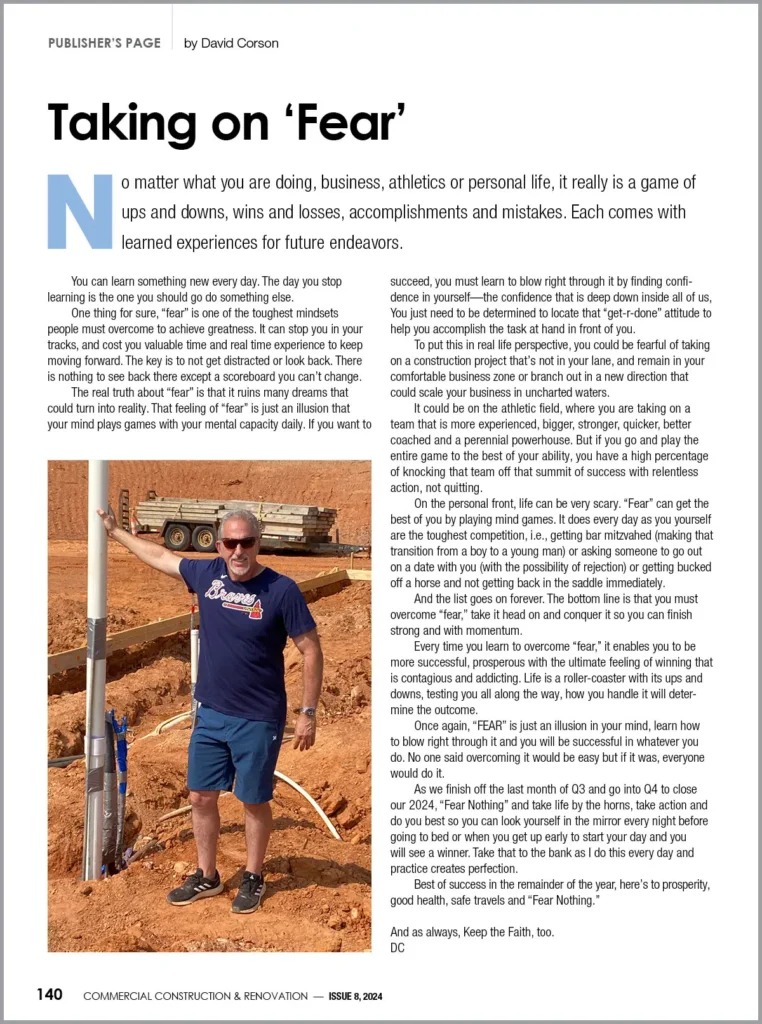A recent update to the Occupational Health & Safety Administration’s (OSHA) 1910 general industry regulation will affect facilities all across the nation. As of November 2018, the general industry’s walking working surface standard 1910.28(b)(9) requires employers to provide a personal fall protection system for workers exposed to a fall of 24ft or greater when climbing permanent, fixed ladders. This article will provide some statistics regarding ladder safety, a summary of the standard update, and provide examples of OSHA-compliant solutions.
Ladder Safety Statistics
Before discussing the update to the legislation and what ladders are affected, it is important to know the statistics regarding ladder safety in the United States. It is estimated that ladders are the cause of nearly 500,000 emergency room visits annually. Additionally, some sources claim around 80% of falls in construction involve ladders, and nearly 300 people die annually from falling off ladders. Workers are required to always maintain three points of contact when climbing a ladder, but accidents can still happen. OSHA updating their regulations will, hopefully, make progress on the alarming number of ladder-related deaths & injuries that occur every year.
Summary of OSHA 1910.28 update
As of November 2018, OSHA requires all new permanent, fixed ladders to be equipped with a personal fall protection system or ladder safety system if there is a risk of falling 24ft or greater to a lower level, or the ground. Historically, ladder cages were accepted as sufficient fall protection, and that is no longer the case. This update does not mandate the removal of existing ladders cages unless the cage interferes with the installation or operation of the newly required fall protection equipment.
Which Ladders Are Affected?
While this author believes that all permanent, fixed ladders should be equipped with a ladder safety system, OSHA begins its requirements at 24ft. Interpretation letters from the public have been written to further define this height requirement, and OSHA’s responses provided valuable insight that helps illustrate the magnitude of this new mandate. This section will provide various examples to describe nuance applications and provide further clarity on eligibility criteria.
To begin, this legislation took effect on November 1, 2018 and applies to all “fixed ladders that extend more than 24 feet above a lower level.” Regardless of the material height of the ladder, a fall protection system is now required on any permanent, fixed ladder that, at any time, exposes a worker to a fall of 24ft or greater to the next lower level. For ladders that were installed before November 1, 2018 OSHA is allowing until November 1, 2036 to install a compliant fall protection system. However, once any maintenance, repairs, or modifications are done to an eligible ladder before the 2036 deadline, that ladder is now considered a “new” ladder. Therefore, it would be immediately subject to the update, and building owners would be required to simultaneously retrofit teir ladder to maintain OSHA compliance.
Many buildings prevent public access to exterior ladders by starting the construction of their roof-access ladders 6-8ft off the ground. It requires contractors and employees to use a portable extension ladder to access the permanent ladders. Technically, this is a legal configuration, but it exposes workers to additional risks in the already dangerous task of accessing their building’s rooftop. Additionally, if the exterior ladder is tall enough to expose a climber to a fall of 24ft or greater, the ladder would be affected by this update and must have a fall protection system installed anyway. Connecting to a ladder safety system from a portable ladder would be cumbersome and could potentially cause a fall to occur while transitioning. Ladder transitions are a leading precursor to falls. Several manufacturers make security gates compatible with ladder safety systems to provide fall protection from the starting level but simultaneously discourage unauthorized use. Business owners & safety managers should be mindful to consider all safety aspects when considering pursuing minimum compliance. Proactive measures performed today can prevent a fall from occurring tomorrow, figuratively speaking.

Graphic B description – Example of a Fixed Ladder Anchor
Image Courtesy of: Diversified Fall Protection
A helpful way to quickly estimate the height of a fixed ladder is to count the rungs. Per OSHA specifications, fixed ladder rungs must be 10”-14” apart but are commonly placed at 12” intervals. If the ladder has more than 20 rungs, it is likely the ladder is eligible for upgrade. Regardless of a ladder’s exact height, decision makers should empathize with their crew and consider the consequences of falling from the ladder, at any point in the climb. A fall from any height can cause debilitating or even fatal injuries. Most organizations promote company values that encourage behaviors that proactively protect the company from risk & its employees from harm. Advocating for proactive safety equipment in a statistically dangerous environment, even when it is not legally required, is amicable behavior. From a financial aspect, proactivity is always the most economical solution if/when an incident occurs, according to several sources. The OSHA Act of 1970 guarantees Americans the right to risk-free workplaces by mandating minimum safety requirements from employers. Most people have a desire to work safely and appreciate it when those in positions of authority provide them with resources to do so effectively, legal requirements aside.
Confirm State OSHA Fixed Ladder Requirements
In the state of California, their state-run Cal/OSHA mandates the same update with the same compliance timeline, but to ladders that expose workers to a fall of 20ft or greater. Washington state’s OSHA mimics the federal height requirements, but has a different compliance timeline. Employers should consult their own state’s requirements to clarify any differences to federal requirements. Multi-state employers will be subject to the local jurisdiction where the ladder physically exists.
OSHA-Compliant Fixed Ladder Fall Protection Solutions
A compliant ladder safety system will be a device that prevents the user from falling to the next lower level should they slip or fall off the ladder at any point during their climb. The most common example of a ladder safety system is a vertical cable or rail-based system, and they are extremely effective at preventing accidental falls for ladder climbers. While differences can exist between different manufacturer models of these systems, most systems operate similarly. It is important to thoroughly review all safety & user manuals before using a product.
Typically, these systems anchor to the top & bottom rungs of the ladder and have a cable or rail that runs the entire vertical length of the ladder. These systems require the ladder climber to have a full-body harness with a chest d-ring and a shuttle device to connect themselves to the ladder system. When a worker must climb the ladder, they connect the shuttle device from their harness’ chest d-ring to the ladder’s cable or rail system. The user should be properly trained on how to keep the shuttle in line with their harness during the climb. If the user should lose their grip on the ladder for whatever reason and begin falling, the shuttle would “lock” into place and prevent the user from falling. Most systems restrict this amount of “freefall” to under 2 feet or less. If a fall occurs, users should treat this like any other fall from heights and be evaluated by a medical professional to ensure no further injuries were incurred. If the user is conscious and simply loses grip of the ladder momentarily, they should be able to grab onto the ladder once again to finish their climb. If the user becomes unconscious, nearby personnel must begin a rescue-retrieval of the user and should call 911 immediately.
Another common example of an OSHA-compliant ladder solution is a Fixed Ladder Anchor. These are usually made from components of the previously described ladder safety systems but without the cable or rail component. These systems typically utilize the top anchor portion and provide the climber with an overhead anchorage to connect a Class 1 SRL (self-retracting lifeline). A tagline should connect the SRL’s snaphook at the top of the ladder to the base where the worker will begin their climb. Instead of a shuttle device that follows the user as they ascend/descend the ladder, the user connects into a personal fall arrest system before they start climbing. Since fall arrest equipment does not prevent a fall from occurring and can only help mitigate injury, employers must be prepared if a fall still occurs. As with all fall arrest equipment, a rescue plan must be implemented by the organization’s Competent Person, and training must be provided to all Authorized Users of the equipment.
This recent update to the OSHA 1910 code can help improve ladder safety in plants, warehouses, and facilities everywhere. Furthermore, this legislation change can help prevent future falls from ladders, thus preventing future fatalities. If companies are still unclear as to if their fixed ladders are affected by this standard, they should reach out to a fall protection partner like Diversified Fall Protection or their local OSHA consultation office.
New author bio:
Philip Jacklin is Continuing Education Program Manager for Diversified Fall Protection. He is an AIA continuing ed provider, QSSP certified, OSHA-30 trained, and has been a partner to the fall protection industry since 2018. Philip has a background in worker advocacy, team leadership, and fostering camaraderie among peers. He enjoys playing music, writing, and spending time in the sunshine with his family in Virginia Beach, VA.
Graphic A description – Example of a cable-based Ladder Safety System
Feature Image Courtesy of: Diversified Fall Protection









 The 2024 virtual Men’s Round Table will be held Q4, 2024, date TBD.
The 2024 virtual Men’s Round Table will be held Q4, 2024, date TBD.
















